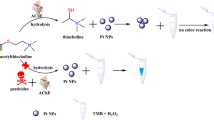Abstract
A novel bio-analytical method has been devised based on the change in catalytic activity of acetylcholinesterase (AChE) enzyme induced by captan, carbosulfan, 2,3,7,8-tetrachlorodibenzodioxin (TCDD) and pentachlorophenol (PCP) for the investigation of inhibition efficiency and sensitivity using Pt/ZnO/AChE/Chitosan bioelectrode. The inhibition curves of captan, carbosulfan, TCDD and PCP were similar to Michaelis–Menten curve. TCDD held the minimum inhibitor Michaelis–Menten constant (\(K_{M}^{I}\)) value (10.2 nM) in comparison with PCP (10.9 nM), carbosulfan (14.5 nM) and captan (7.9 × 103 nM). The maximum inhibition of AChE enzyme by captan was about 100 %, which was much higher than that of TCDD (72.7 %), PCP (68.1 %) and carbosulfan (47.7 %). The calculated theoretical sensitivity was in the order of TCDD > PCP > carbosulfan > captan. Comparing with TCDD (35.3 %), PCP (47.8 %) and carbosulfan (20.9 %), only the inhibition efficiency of captan (55.0 %) was the maximum. The developed bioelectrode exhibited high recovery and low relative standard deviation in local tap water samples.




Similar content being viewed by others
References
Dhull V, Gahlaunt A, Dilbaghi N, Hooda V (2013) Acetylcholinesterase biosensors for electrochemical detection of organophosphorus compounds: a review. Biochem Res J 2013:1–18
Du D, Huang X, Cai J, Zhang A (2007) Comparison of pesticide sensitivity by electrochemical test based on acetylcholinesterase biosensor. Biosens Bioelectron 23:285–289
Du D, Chen S, Cai J, Zhang A (2008) Electrochemical pesticide sensitivity test using acetylcholinesterase biosensor based on colloidal gold nanoparticle modified sol–gel interface. Talanta 74:766–772
Gahlaut A, Gothwal A, Chhillar AK, Hooda V (2012) Electrochemical biosensors for determination of organophosphorus compounds: review. Open J Appl Biosens 1:1–8
Juraske R, Mutel CL, Stoessel F, Hellweg S (2009) Life cycle human toxicity assessment of pesticides: comparing fruit and vegetable diets in Switzerland and the United States. Chemosphere 77:939–945
Sassolas A, Simon BP, Marty JL (2012) Biosensors for pesticide detection: new trends. Am J Anal Chem 3:210–232
Singh RP, Kim YJ, Oh BK, Choi JW (2009) Glutathione-s-transferase based electrochemical biosensor for the detection of captan. Electrochem Commun 11:181–185
Acknowledgments
The authors are grateful to the Department of Science and Technology, New Delhi, for their financial support [DST/TSG/PT/2008/28, SR/FST/ETI-284/2011(C) and (Nano Mission Council (No. SR/NM/PG-16/2007)]. The research was supported by Professor T. R. Rajagopalan research fund, SASTRA University. We also acknowledge SASTRA University, Thanjavur for extending infrastructural support to carry out the study.
Author information
Authors and Affiliations
Corresponding author
Rights and permissions
About this article
Cite this article
Nesakumar, N., Ramachandra, B.L., Sethuraman, S. et al. Evaluation of Inhibition Efficiency for the Detection of Captan, 2,3,7,8-Tetrachlorodibenzodioxin, Pentachlorophenol and Carbosulfan in Water: An Electrochemical Approach. Bull Environ Contam Toxicol 96, 217–223 (2016). https://doi.org/10.1007/s00128-015-1705-3
Received:
Accepted:
Published:
Issue Date:
DOI: https://doi.org/10.1007/s00128-015-1705-3




